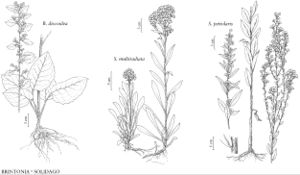Difference between revisions of "Solidago multiradiata"
Hort. Kew. 3: 218. 1789.
imported>Volume Importer |
GeoffLevin (talk | contribs) (Removed the invalid name Solidago heterophylla from synonymy and added an explanation to the discussion.) |
||
| Line 31: | Line 31: | ||
|name=Solidago dilatata | |name=Solidago dilatata | ||
|authority=A. Nelson | |authority=A. Nelson | ||
| − | |||
| − | |||
| − | |||
| − | |||
|rank=species | |rank=species | ||
}} {{Treatment/ID/Synonym | }} {{Treatment/ID/Synonym | ||
| Line 75: | Line 71: | ||
|elevation=0–3700 m | |elevation=0–3700 m | ||
|distribution=Alta.;B.C.;Man.;N.B.;Nfld. and Labr.;N.W.T.;N.S.;Nunavut;Ont.;Que.;Sask.;Yukon;Alaska;Ariz.;Calif.;Colo.;Idaho;Mont.;N.Mex.;Oreg.;Utah;Wash.;Wyo. | |distribution=Alta.;B.C.;Man.;N.B.;Nfld. and Labr.;N.W.T.;N.S.;Nunavut;Ont.;Que.;Sask.;Yukon;Alaska;Ariz.;Calif.;Colo.;Idaho;Mont.;N.Mex.;Oreg.;Utah;Wash.;Wyo. | ||
| − | |discussion=<p><i>Solidago multiradiata</i> is the North American species most closely related to S. virgaurea, the type species of the genus, native to mostly arctic and alpine regions of Eurasia. Plants of <i>S. multiradiata</i> from the Rocky Mountains have been treated as <i></i>var.<i> scopulorum</i>; they differ so little from those of other parts of the range that recognition of the variety without further support does not appear justified.</p> | + | |discussion=<p><i>Solidago multiradiata</i> is the North American species most closely related to <i>S. virgaurea</i>, the type species of the genus, native to mostly arctic and alpine regions of Eurasia. Plants of <i>S. multiradiata</i> from the Rocky Mountains have been treated as <i></i>var.<i> scopulorum</i>; they differ so little from those of other parts of the range that recognition of the variety without further support does not appear justified.</p> |
| + | <p><i>Solidago heterophylla</i> Nuttall ex A. Gray is an invalid name (pro synonym of <i>S. multiradiata</i> var. <i>scopulorum</i>) that pertains here.</p> | ||
|tables= | |tables= | ||
|references= | |references= | ||
| Line 87: | Line 84: | ||
|rank=species | |rank=species | ||
|parent rank=subsection | |parent rank=subsection | ||
| − | |synonyms=Aster multiradiatus;Solidago algida;Solidago cusickii;Solidago dilatata | + | |synonyms=Aster multiradiatus;Solidago algida;Solidago cusickii;Solidago dilatata;Solidago multiradiata var. arctica;Solidago multiradiata var. scopulorum;Solidago rubra;Solidago scopulorum;Solidago virgaurea var. arctica;Solidago virgaurea var. multiradiata |
|basionyms= | |basionyms= | ||
|family=Asteraceae | |family=Asteraceae | ||
Latest revision as of 15:04, 30 January 2023
Plants (3–)10–30(–80) cm; caudices branched. Stems 1–10(–30+), decumbent to erect, slender, tufted, proximally glabrous or sparsely hairy, densely short-hispido-strigose in arrays. Leaves: basal and proximal cauline petiolate; petioles winged, margins ciliate; blades linear-oblanceolate to spatulate, 10–170 × 3–30 mm, serrate to crenate near apices; distal cauline sessile; blades sometimes subclasping stems, ovate to linear-lanceolate, 16–20 × 7–11 mm, margins often distinctly ciliate. Heads 4–75(–100+), not secund, in dense, round-topped corymbiform arrays; branches white villous. Peduncles 5–6 mm, villous; bracteoles 0–2, linear-lanceolate to lanceolate. Involucres 4–8 mm. Phyllaries unequal to subequal, outer linear-lanceolate to lanceolate, lengths ± 2/3 inner, margins ciliate, apices acute to attenuate. Ray florets 12–18; laminae 3–4 × 0.5–1 mm. Disc florets 10–35; corollas 3–5 mm, lobes 0.3–1 mm. Cypselae 1.5–4 mm, sparsely to moderately strigose; pappi 3–4 mm (inner bristles clavate). 2n = 18, 36.
Phenology: Flowering Jul–Sep.
Habitat: Tundra and tundralike habitats, alpine slopes and meadows
Elevation: 0–3700 m
Distribution

Alta., B.C., Man., N.B., Nfld. and Labr., N.W.T., N.S., Nunavut, Ont., Que., Sask., Yukon, Alaska, Ariz., Calif., Colo., Idaho, Mont., N.Mex., Oreg., Utah, Wash., Wyo.
Discussion
Solidago multiradiata is the North American species most closely related to S. virgaurea, the type species of the genus, native to mostly arctic and alpine regions of Eurasia. Plants of S. multiradiata from the Rocky Mountains have been treated as var. scopulorum; they differ so little from those of other parts of the range that recognition of the variety without further support does not appear justified.
Solidago heterophylla Nuttall ex A. Gray is an invalid name (pro synonym of S. multiradiata var. scopulorum) that pertains here.
Selected References
None.
